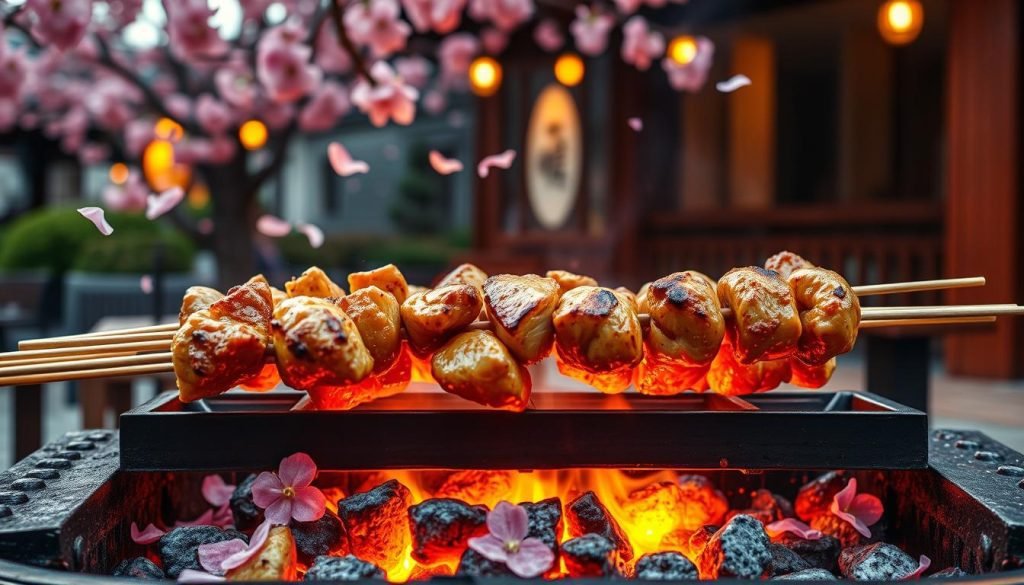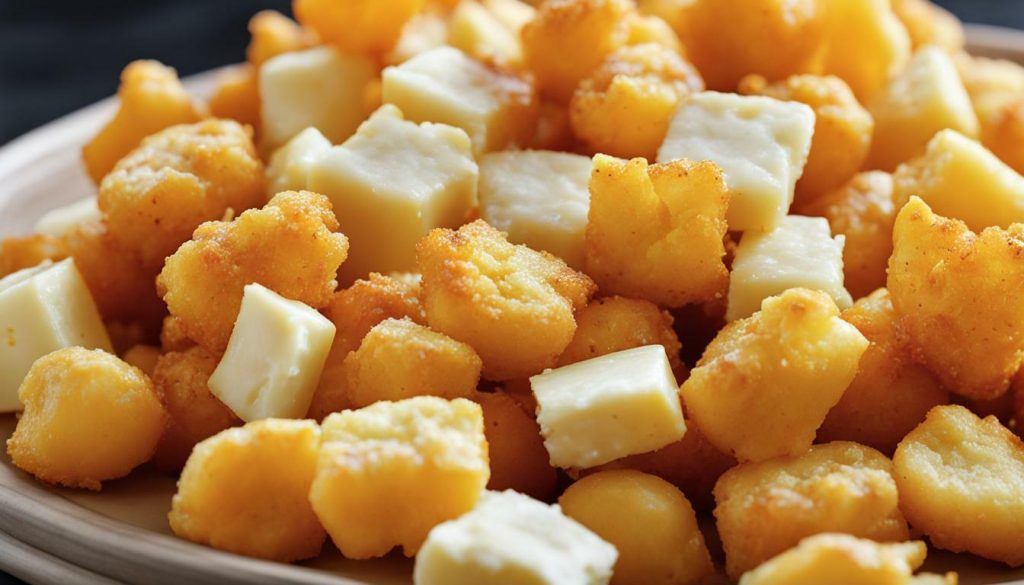Standing around a grill is magical. The air is filled with the smell of chicken. It’s a treat for the senses.
I first tried yakitori in Tokyo. It was in a lively izakaya. Friends laughed and enjoyed tender, juicy skewers. Each bite was a mix of flavors.
Yakitori is more than food. It’s a way to connect with others. It’s a taste of Japan you can make at home.
I’m excited to share yakitori with you. I have a real recipe that shows its true taste. Making yakitori is a great way to impress your guests or treat yourself.
Introduction to Yakitori
The history of Yakitori is fascinating. It started in Japan’s Edo period. This dish was once a street food but now is a favorite in Japanese cuisine.
Yakitori is all about grilling chicken skewers perfectly. Each piece tells a story of Japan’s cooking traditions. It offers flavors that are hard to resist.
There are two main types of Yakitori: tare and shio. Tare has a sweet soy sauce glaze for a rich taste. Shio uses salt to highlight the chicken’s natural flavor.
This variety shows the creativity in making grilled chicken skewers. It inspires both chefs and home cooks.
My love for Yakitori is more than just taste. Knowing its history makes every meal special. It turns simple ingredients into a memorable dining experience.
Understanding the Ingredients for Yakitori
Yakitori starts with the right ingredients. The marinade is key, made from soy sauce, mirin, and sake. These add flavor and make the chicken tender. I also add garlic or ginger for more taste.
Getting the right amounts and preparing well makes Yakitori special.
Essential Ingredients for the Marinade
To make the perfect marinade, you need:
- Soy sauce: This gives a deep umami flavor.
- Mirin: Sweet rice wine adds depth.
- Sake: It brings complexity and balances the taste.
Mix soy sauce and mirin equally, then add sake. This mix coats the chicken with rich flavor. You can adjust the mix to taste.
Choosing the Right Chicken Thighs
Choosing the right chicken is key for Yakitori. Thighs are best for their tenderness and flavor. Here’s what to look for:
- Meat quality: Choose firm, vibrant-colored thighs.
- Organic and free-range options: They taste better and are better for you.
- Freshness: Get thighs from a trusted butcher or market.
High-quality chicken makes your Yakitori taste better. It ensures a great meal. Knowing what ingredients to use makes your dish special.
How to Prepare Yakitori (Grilled Chicken Skewers)
Preparing Yakitori is fun and brings Japan’s flavors to my kitchen. It starts with marinating the chicken, making each bite better. My recipe makes sure all skewers are the same size for even cooking. Let’s get started on making Yakitori.
Step-by-Step Preparation of Ingredients
First, I gather all my ingredients and tools. Here’s a simple guide for making Yakitori:
- Cut the chicken thighs into pieces, about 1 to 2 inches each. This size makes them juicy.
- Whisk together soy sauce, mirin, and sugar for a tasty marinade.
- Soak the chicken in the marinade for at least 30 minutes. This lets the flavors soak in.
- After marinating, let the chicken rest for a few minutes before skewering.
Skewering Tips for Perfect Yakitori
Skewering is key for Yakitori’s look and taste. Here are some tips:
- Use bamboo or metal skewers. Soak bamboo in water for 30 minutes to avoid burning.
- Space the chicken pieces apart on the skewer for even cooking.
- Vary the chicken and vegetable arrangement on skewers for a nice look.
With these tips, I’m ready to make delicious Yakitori at home. Enjoy making it and eating it.
Grilling Techniques for Authentic Flavors
Grilling Yakitori is more than just putting chicken on a grill. It’s about using real grilling methods for the best taste. Direct grilling gives chicken a nice char and cooks it evenly. Using a grill pan keeps juices in, making the meat juicy.
I always choose binchotan charcoal for cooking. It burns hot and adds a smoky flavor to Yakitori. Keeping the grill at medium-high heat is key. This way, the chicken gets a nice char without drying out.

Timing is key when grilling Yakitori. Here’s a table with cooking times for different skewers:
| Type of Skewers | Cooking Time (minutes) | Desired Temperature (°F) |
|---|---|---|
| Chicken Thighs | 8-10 | 165 |
| Chicken Breasts | 6-8 | 165 |
| Vegetables | 4-6 | cooked until tender |
| Yakitori with Sauce | 10-12 | 165 |
By using these grilling methods, my Yakitori is a hit for its taste. It gives a memorable dining experience that shows off Japanese cuisine.
Serving Suggestions and Pairings for Yakitori
Enjoying Yakitori is better with the right sides and drinks. These choices make your meal special and memorable.
Perfect Sides to Complement Yakitori
I like to add Japanese sides to Yakitori. They taste great together and look nice too. Here are some good choices:
- Sesame Cucumber Salad: It’s a mix of cucumbers, sesame oil, soy sauce, and sesame seeds. It’s fresh and light, perfect with grilled meat.
- Pickled Vegetables: Pickled veggies, or tsukemono, are tangy and tasty. Try daikon radish, carrots, or cucumbers for a fun crunch.
- Steamed Rice: Steamed rice is great for soaking up Yakitori sauce. Add scallions or nori for extra taste.
Recommended Beverages to Enjoy with Yakitori
Choosing the right drink can make Yakitori even better. Here are my top picks:
- Asahi Beer: This Japanese beer is crisp and goes well with Yakitori’s flavors.
- Sake: Cold sake, especially Junmai or Ginjo, is a great match. It cleanses your palate.
- Umeshu (Plum Wine): This sweet plum wine is a fun contrast to savory dishes.
For something new, try Japanese cocktails. A yuzu mojito or sake martini adds unique flavors that go well with Yakitori.
My Personal Experience with Yakitori
My journey into Yakitori started at a food festival. The smell of grilled chicken drew me in. That first bite took me to Japan.
It sparked a love for Yakitori and a wish to make it at home. This story is about more than taste. It’s about the feelings it brings.
Starting to make Yakitori was tough. The first time, it was messy. But each try made me better.
I learned how to grill and make the marinade just right. It turned cooking into a fun experience. Yakitori is about creativity and sharing meals with family.
Now, making Yakitori reminds me of those first tastes. Each skewer brings back happy memories. I hope you try making Yakitori too.
It’s a journey that improves your cooking skills. It also brings joy and laughter to the table.






